In today’s world of online, well, everything, every internet medium can present a business opportunity. Webinars are one such thing; they’ve turned into a powerful tool that can engage customers and generate leads if done right. That’s why we’ve compiled some relevant webinar statistics which demonstrate the significance of not just hosting interactive events online but doing so the right way. So, read on to learn how to successfully incorporate webinars in your marketing and business strategy.
Webinar Statistics (Editor’s Choice)
- Webinars get approximately 16 attendees on average. (MegaMeeting)
- Between 40% and 50% of the people who register end up attending the webinar. (ReadyTalk)
- 46% of webinar attendees register for skill improvement. (Digital Marketing Community)
- 76% of marketers say webinars enable them to drive more leads. (Blogging X)
- Technology and software companies account for 29% of all webinars. (Digital Marketing Community)
- 94% of webinars are on-demand which attendees find to be super convenient. (ProfitFromTech)
- 92% of webinar attendees say the end of your event must include a live Q&A session. (Medium)
Must-Know Webinar Stats & Facts
1. One webinar per week is what most people would commit to.
Your targeted audience can only attend so many of these online events. This means that you’ll be competing for the attention of your audience not only with other webinars from your industry but from all other industries as well.
(Medium)
2. Webinars get 16 attendees on average.
Webinars typically don’t cater to thousands of interested people worldwide. Recent studies note that the average webinar attendance rate is at around 16. The upside is the opportunity to get some alone time with your audience, where you can interact at your leisure and in a comfortable manner. This can make the audience feel more relaxed, and ultimately help you turn the prospects genuinely interested in your product or service into actual customers.
(MegaMeeting)
3. Between 40% and 50% of the people who register end up attending the webinar.
Although data shows that webinar organizers receive almost 300 to 500 registrants on average, webinar attendance statistics indicate that only half of the registrants end up attending. There could be many reasons why people register and then fail to show. The numbers, however, suggest that B2C organizers typically receive about 260 registrants which poses a more severe problem for B2C companies and webinars than B2B ones.
(ReadyTalk)
4. Webinar stats show 35.6% of webinars are online courses and training sessions.
Over one-third of webinars are online courses and training sessions. Data for 2020 shows that 27.8% include coaching certification programs, game development workshops, virtual classes, etc. The ClickMeeting report on the State of Webinars further shows a solid 27.8% of online events were product and marketing demos, while 11% were business meetings and another 22.9% had other purposes.
(ClickMeeting)
5. Webinar statistics confirm that 46% of webinar attendees register for skill improvement.
Research shows that online events in the form of internet seminars are a favorite among people and marketers who are looking to train themselves better. Webinars are not only a marketing method, but also happen to be particularly useful as a way of spreading knowledge, improving skills, and sharing information altogether.
(Digital Marketing Community)
6. 76% of marketers say webinars enable them to drive more leads.
What’s more, webinar marketing statistics show that 75% of marketers further use these online interactive events to build their brand. Live webinars allow you to not only interact with potential customers in real-time but also to build trust and boost your brand’s image and credibility. At the same time, you’re able to showcase your products or demonstrate the services you provide, while answering any questions right away.
(Blogging X)
7. More than 83% of marketers consider webinars an effective marketing strategy.
Webinar statistics on marketing, however, also show that only 41% of marketers have participated or hosted one of those online events. More recent webinar reports, however, mention 42% of marketers are already planning to host a webinar in 2021. So, now is the time to get on the webinar wagon before other marketers figure out what they’ve been missing. After all, the early (in this case, earlier) bird catches the worm.
(Wyzowl)
8. Technology and software companies account for 29% of all webinars.
Webinars have become an essential marketing tool for tech and software companies. Webinar stats further reveal that financial services companies produce 14% of webinars, while education accounts for 11%, and consulting covers 10%. Government and healthcare are at 7%, while retail, manufacturing, and insurance account for 4%. The second to last position belongs to advertising, marketing, public relations, hospitality, travel, tourism, and real estate (3%). Lastly, nonprofits account for just 1%.
(Digital Marketing Community)
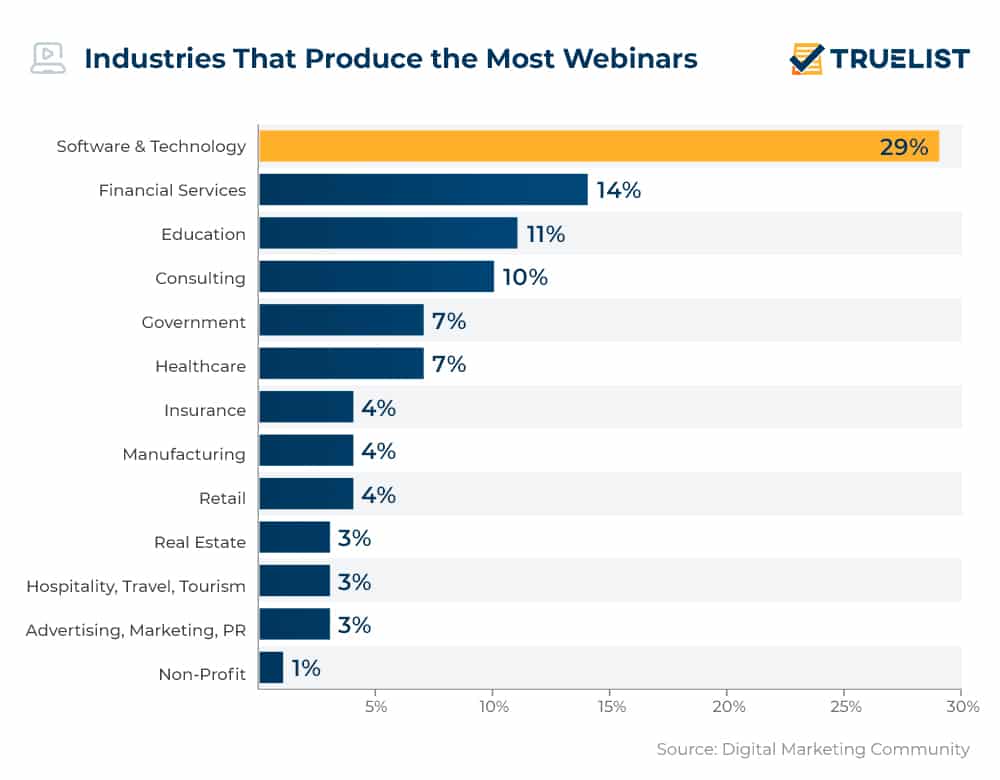
9. With a participation rate of 63%, the pharmaceutical industry has the highest average attendance rate among industries.
Webinar watch stats show that pharma sector webinars record very high average attendance rates, while the advertising industry events perform the worst (33% attendance). SaaS meanwhile has an average attendance ratio of 46%, while the internet industry ranks slightly lower with 39%. The consulting industry proudly takes the third place on the list with a 50% average attendance, while education belongs on the lower end of the scale with just 44%. Financial services are a close second, boasting an impressive 61% average attendance rate.
(Livestorm)
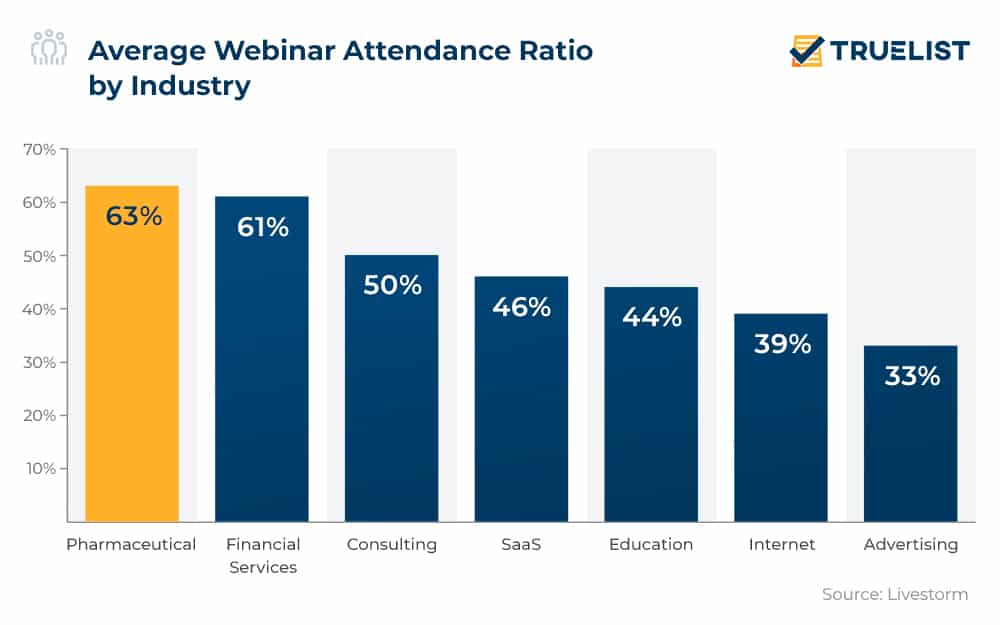
10. B2B webinar statistics show 61% of marketers use them as a tactic in their content marketing strategy.
Although posting fresh content on social media, according to 92% of marketers, is one of the most effective marketing tools, latest data confirms webinars are also a very convenient tactic which is why 61% of marketing professionals use them. Moreover, webinars are not only suitable for effectuating the content marketing strategy but studies show they also provide an excellent way for 73% of B2B marketers in realizing their endeavours to produce high-quality leads.
(Cloud Income)
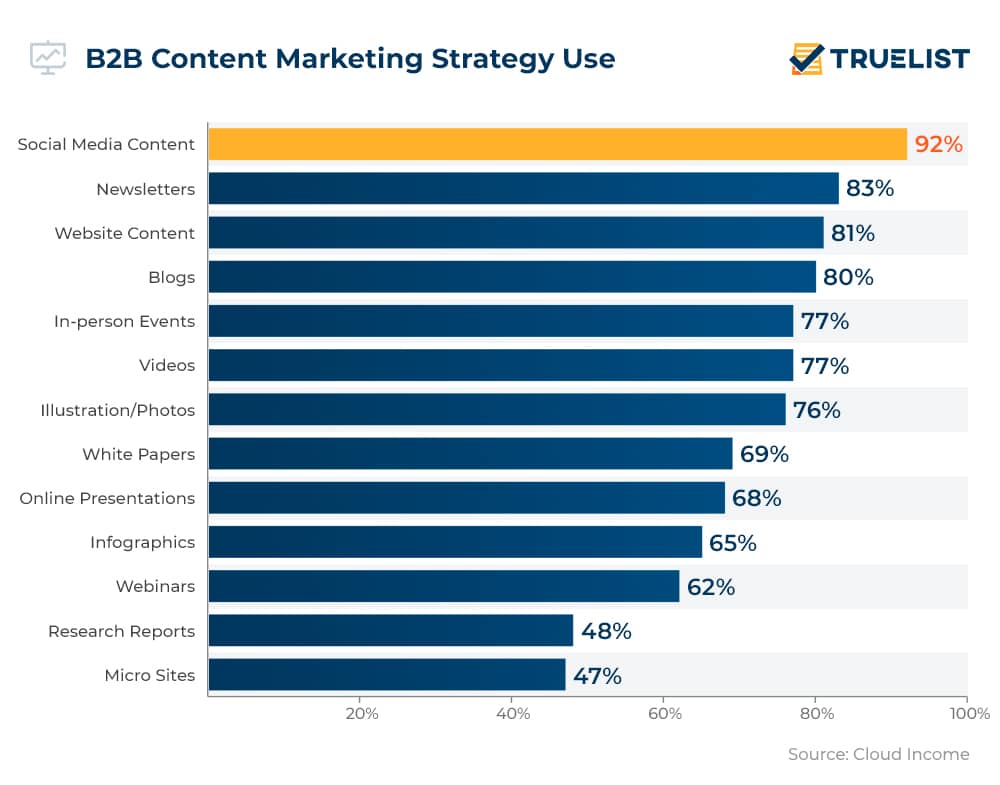
11. At 54%, internal communications webinars boast the highest conversion rate.
The latest webinar conversion stats point to an average conversion rate of 46% for all types of webinars. What is interesting though is that webinars aimed at improving internal communication have the highest conversions at 54% and training webinars come in second with a rate of 45%. Continuing education webinars generate a 40% conversion rate while marketing webinars point to a somewhat low conversion rate at 36%.
(Venture Harbour)
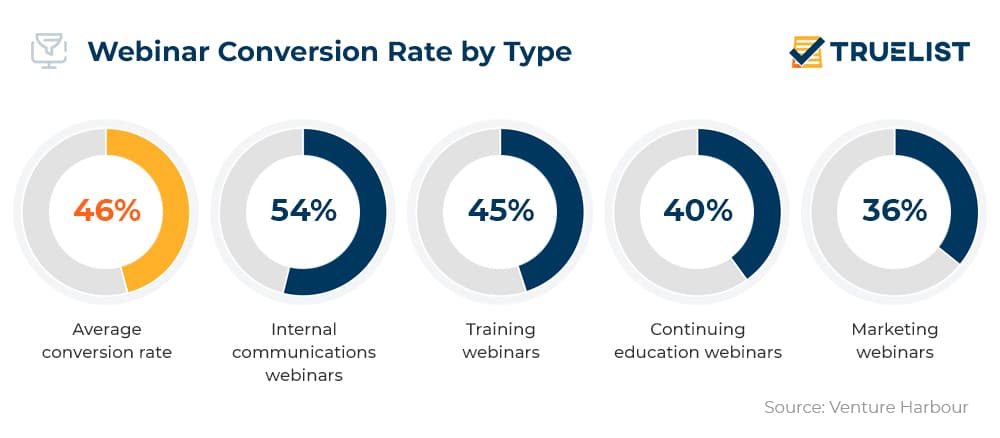
Webinar Statistics & Tips to Help You Organize a Successful Event
12. 94% of webinars are made on-demand which attendees find to be super convenient.
Recent studies showed that 18% of people who have registered to attend a webinar but were unable to, managed to do so over the weekend. Since nowadays literally everyone is on a tight schedule, marketers have adapted to this trend by making a staggering 94% of webinars available on-demand. Here’s another tip to boost your webinar attendance rates: start promoting your on-demand webinars on Friday so people attend the event from the comfort of their home over the weekend.
(ProfitFromTech)
13. 25% of participants sign into webinars from their mobiles.
A quarter of webinar attendees sign into webinars from their handheld devices. Considering how much time people spend on their mobiles, hiring an app development company to make sure that joining your event from a smartphone will be as seamless as possible will definitely bring more attendees. After all, optimizing both your online event and the registration process could very well be a perfect advertising tactic and a great way to ensure the participation of mobile-dependent audiences.
(Cloud Income)
14. It’s best to ensure a minimum of four weeks to promote a webinar.
Webinar effectiveness statistics suggest that even though 59% of registrations happen a week before the event, you need to get the word out at least four weeks in advance. Promotion leads to awareness, awareness leads to attendance, attendance drives engagement, and engagement generates conversion. In fact, you can boost the registration rate for your webinar by as much as 12% if you start promotions at least four weeks before the date of the online event.
(Digital Marketing Community)
15. Email is the channel of choice for 57% of attendees who register for a webinar.
Best practices for webinars show that using email is by far the most effective method to ensure successful registration and sign-ups for your events. Stats further reveal that email is four times as successful as social media. So, to ensure the maximum registrations for your upcoming online events, you should focus on email, while throwing in some social media invites or ads to mix it up.
(GoToMeeting)
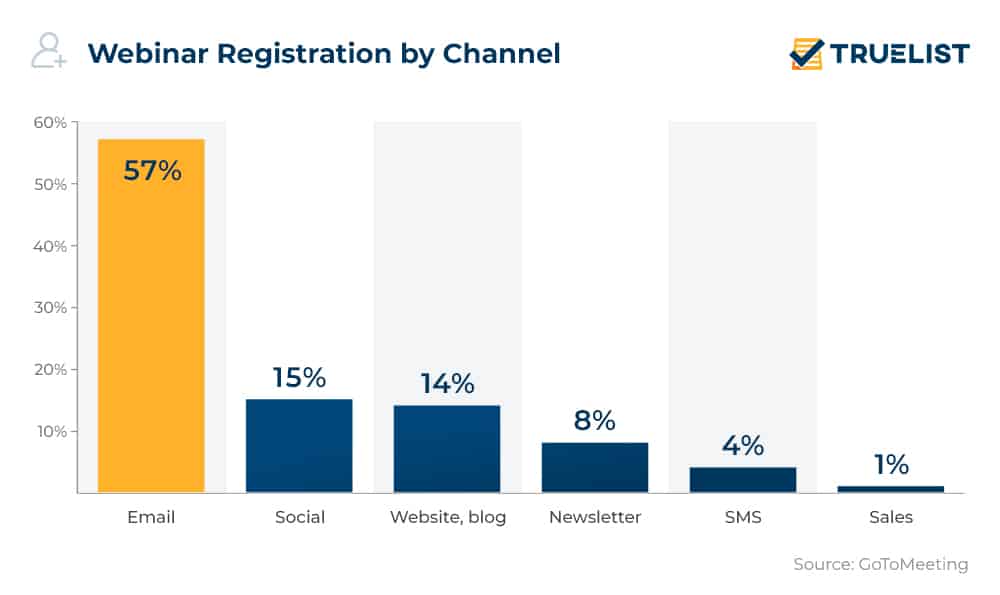
16. Webinar statistics show that 23% of pre-registrations happen on Wednesdays.
Professionals interested in attending webinars are most likely to pre-register in the middle of the week. This is followed by Tuesdays with 22% and Thursdays with 19%. The worst days for pre-registration are—not surprisingly—Saturdays and Sundays with two percent each.
(Smart Insights)
17. A webinar registration page shouldn’t have more than 5-7 questions.
The registration process can either make or break your webinar attendance. Webinar facts indicate that registration forms shouldn’t have more than 5-7 questions on average. A simple registration form with only a couple of essential questions will go a long way towards adding up the tally when it’s all said and done.
(Ready Talk)
18. Leveraging the most out of webinars means hosting them around 11 AM PST (2 PM EST).
Latest reports on webinar benchmarks show that 14% of registrants attended webinars hosted at 11 AM PST. This marks the highest percentage meaning that this would be the best time to host a webinar. Other times of day meanwhile yield smaller attendance: 13% for 10 AM, 9% for noon, and so on. So, either mid-morning or the middle of the day seems the best time to run webinars. That said, remember to hold off running webinars around 1 PM since that’s lunchtime.
(On 24)
19. Webinars of between 30 minutes and 1 hour drive maximum audience engagement.
Webinar engagement statistics provide essential insight for hosts regarding the optimal length of their sessions. While short events might not be informative enough, overly long webinars risk becoming boring and swamped with information. Either way, you’re at risk of decreasing the engagement of your audience, ultimately leading to lower conversion rates and losing sales.
(Livestorm)
20. The average duration of webinars set up around the topics of internet and SaaS is 43 and 40 minutes, respectively.
Similarly, webinar trends show that topics like financial services typically last around 60 minutes, pharmaceuticals last 22 minutes, education events are programmed at 55, advertising at 40, and lastly, consulting sessions last 37 minutes per webinar, on average. Just over 40 minutes is the sweet spot for your webinar and one that ensures optimal audience engagement.
(Livestorm)
21. 92% of webinar attendees say the end of your event must include a live Q&A session.
One way to improve your webinar metrics further is to include a Q&A session, with attendees generally expecting one. That said, you might not get any questions at all at the end of your event. In that case, you can simply take over and throw in some frequently asked questions. This might encourage your audience to come up with questions of their own or, at the very least, will add more authority to you as a host.
(Medium)
22. A significant 25% of all registrants use the replay option on webinars.
If your registration rate is high, but attendance ends up being low, the replay option is a terrific way to get the ones who didn’t show up the first time to view the replay. Installing and promoting the replay option can also boost your webinar conversion rates: once the event is over, your audience may want to go back and brush up on some of the tips, tricks, or info, and subsequently reach out. After all, stats show only 22% of registrants watch webinars live.
(Ring Central)
Frequently Asked Questions
How to drive webinar attendance?
There are different ways to increase your webinar attendance over time. For example, offering relevant and original content in your online event is a particularly good way to attract more people.
Once you’ve gotten the content up and running, you can also try timing your webinar session to last more than 30 minutes and less than an hour. Let’s not forget the importance of live Q&A sessions at the end of each online event: this feature is a favorite among the vast majority of those that attend webinars.
(Frogdog)
What is a good webinar attendance rate?
40% to 50% is a relatively solid attendance rate, according to webinar statistics. And while high attendance rates are a good thing, a lower-than-average attendance rate isn’t necessarily bad given that it will result in a more intimate experience and could have a better conversion rate. Typically speaking, less than half of all webinars get above-average rates.
(Outgrow)
How long should my webinar be?
This also depends on your industry, as well as the topic of your webinar but a webinar should ideally last 60 to 90 minutes. A study from Livestorm, on the other hand, reveals that the average duration of webinars set up around the topics of internet and SaaS is 43 and 40 minutes, respectively. Other topics like advertising last around 40 minutes while the consulting industry spends 37 minutes per webinar, on average. The conclusion here is that if you’re wondering how to improve webinars, you need to remember that just over 40 minutes is the sweet spot for your webinar and one that ensures optimal audience engagement.
(Livestorm)
What is the best day for a webinar?
Tuesdays show the highest percentage of YoY attendance with 27% and consequently are the best days of the week to organize a webinar. However, Wednesdays and Thursdays are also well ranked with 21% and 20% attendance rate, respectively. Latest trends indicate the best time to hold a webinar is mid-week.
(Smart Insights)
Final Remarks
Webinars have become an essential marketing tool, given their information benefits and practicality. Your attendees don’t need to splurge for accommodation or commute but can enjoy your presentation and participate from the comfort of their own homes. These webinar statistics further underscore the potential of this marketing channel, showing that the sooner you master it, the faster you’ll grow your business.
Sources: Medium, MegaMeeting, ReadyTalk, ClickMeeting, Digital Marketing Community, Blogging X, Wyzowl, Livestorm, Cloud Income, Venture Harbour, ProfitFromTech, GoToMeeting, Smart Insights, Ready Talk, On 24, Ring Central, Frogdog, Outgrow

